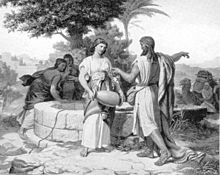Josef Zenker
Josef Zenker (born July 9, 1832 in Neurode , Glatz district , † May 31, 1907 in Munich ) was a German history painter .
Life
Zenker was the son of a large shoemaker. His artistic talent was shown early on. Since his family could not support him in his desire to become a painter, he himself looked for an apprenticeship with a neighboring porcelain painter after finishing school. After completing his apprenticeship, he moved to Frankenstein and found work with a decorative painter, in whose workshop he was well trained and was allowed to independently manufacture figural church jewelry.
Presumably with the support of his Frankenstein master, Zenker went to Munich in 1856, where Wilhelm Hauschild and Aloys Richter, both of whom came from the neighboring town of Schlegel, were well-known history painters. In Munich, Zenker found sponsors who enabled him to attend the Royal Academy of Fine Arts for seven years . He became a student of professors Philipp von Foltz , Joseph Schlotthauer and Johann von Schraudolph and turned almost exclusively to church art. With the painting Rebekka am Brunnen he won a first prize at the Munich Art Academy. He was a member of the Munich Association for Christian Art, founded in 1860 .
From 1875 to 1876 Zenker painted a cycle of murals for the Church of St. Leodegar in Gebweiler . He received further orders for the churches in Altkirch / Alsace , Frankenried and Kirchheim in Swabia , Bad Reichenhall ( Aegidien Church ), and the pilgrimage church in Vilsbiburg . For the St. Antonius Church of the Capuchins in Munich he painted the paintings for four altars that were delivered from the workshop of his compatriot Joseph Elsner . However, altars and paintings were removed from the church at the beginning of the 1960s because they no longer corresponded to contemporary tastes.
Zenker made great contributions to church art . After he could no longer accept the large church commissions for health reasons, he turned to smaller paintings. He portrayed high clerics , including Bishop Michael von Rampf of Passau and Archbishop Franz Joseph von Stein of Munich-Freising . Due to an eye problem, he was unable to do his job in the last years of his life. After an unpretentious and modest life, he died on May 31, 1907.
literature
- Hyacinth Holland : Zenker, Josef . In: Biographisches Jahrbuch and Deutscher Nekrolog from January 1 to December 21, 1907 . tape 12 . Georg Reimer, Berlin 1909, p. 114–115 ( Textarchiv - Internet Archive ).
- Festival of the Association for Christian Art in Munich. Munich 1910, p. 90.
- Joseph Wittig : Chronicle of the community Schlegel. Published by the home community Schlegel, self-published Hattingen / Neuss 1983, pp. 597-599.
- Zenker, Josef . In: Hans Vollmer (Hrsg.): General lexicon of fine artists from antiquity to the present . Founded by Ulrich Thieme and Felix Becker . tape 36 : Wilhelmy-Zyzywi . EA Seemann, Leipzig 1947, p. 460 .
- Karl Schindler: That was their life - important counters from four centuries. Marx-Verlag 1975.
| personal data | |
|---|---|
| SURNAME | Zenker, Josef |
| ALTERNATIVE NAMES | Zenker, Joseph |
| BRIEF DESCRIPTION | German history painter |
| DATE OF BIRTH | July 9, 1832 |
| PLACE OF BIRTH | Neurode , district of Glatz |
| DATE OF DEATH | May 31, 1907 |
| Place of death | Munich |
